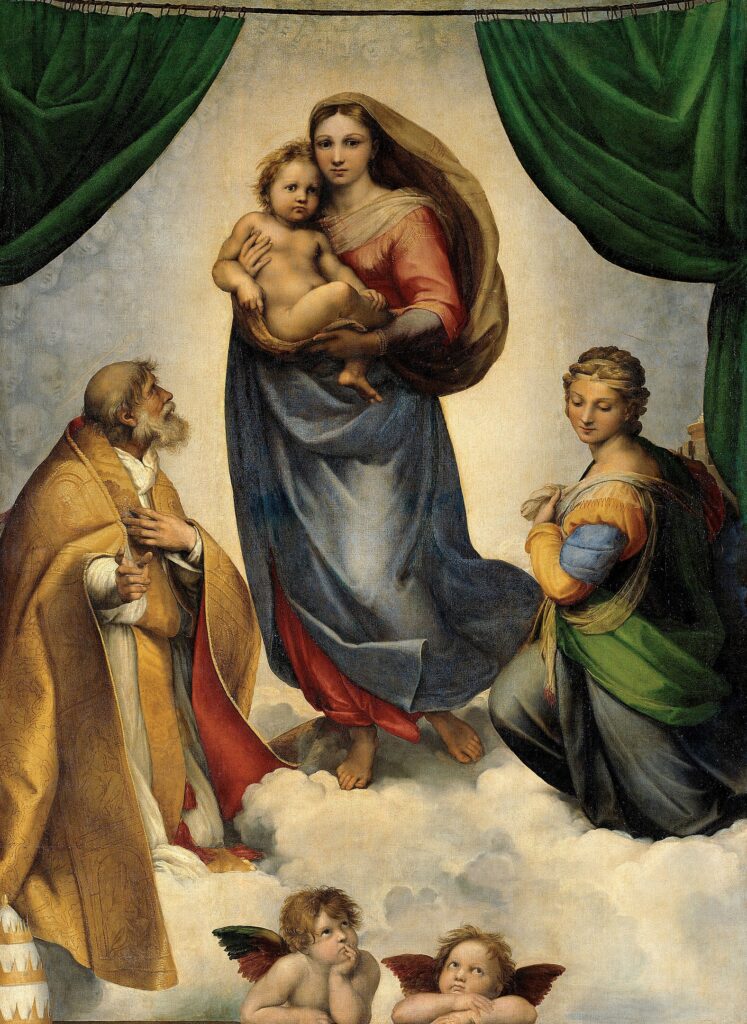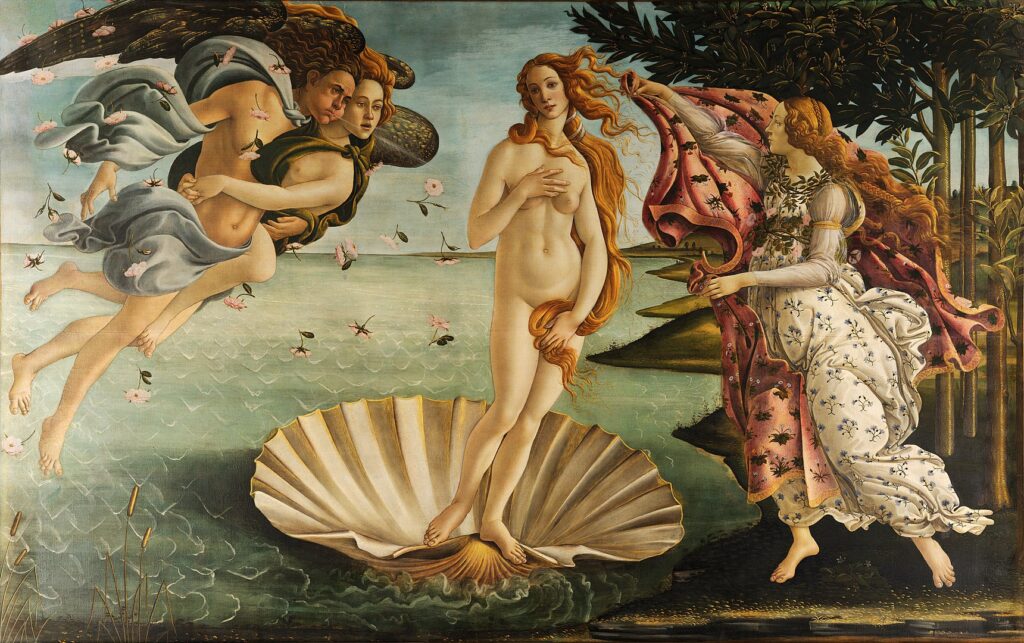Renaissance humanism was a broad and multifaceted movement that encompassed a range of intellectual, cultural, and social developments, including the rediscovery of classical texts.
Renaissance art (1350 – 1620 AD) is the painting, sculpture, and decorative arts of the period of European history known as the Renaissance, which emerged as a distinct style in Italy in about AD 1400, in parallel with developments that occurred in philosophy, literature, music, science, and technology. Renaissance art took its foundation from the art of classical antiquity and was perceived as the noblest of ancient traditions. Along with Renaissance humanist philosophy, it spread throughout Europe, affecting both artists and their patrons with the development of new techniques and artistic sensibilities. For art historians, Renaissance art marks the transition of Europe from the medieval period to the Early Modern age.
Read About: Humanism Theory: Insights and Lessons for Modern Society
Renaissance: A Golden Age of Artistic Innovation and Mastery

In the Renaissance Age, the concept of art was intertwined with religious and secular traditions. Paintings, sculptures, and drawings were not solely evaluated for their aesthetic value, but also for their functional purposes in specific contexts. Altarpieces, such as Raphael’s Sistine Madonna, were not considered works of art as we understand them today, but rather as devotional images with ritual purposes. Beholders of such works in the 16th century encountered them within the context of actual religious rituals.
However, the Renaissance also marked the emergence of the modern concept of “Art” as a separate entity, with a capital “A.” The status of the artist as a creative genius, the importance of originality, and the use of aesthetic criteria to judge works of art were all notions that gained prominence during this period.
Renaissance folk certainly appreciated the aesthetic qualities of art – they paid big bucks for works by famous artists and valued artistic ability and innovation. But in many cases, art’s non-aesthetic functions were paramount, be they social, political, or practical. And let’s not forget the sheer physical effort required to produce these works of art – carving a massive marble statue by hand, painting a fresco on a towering church wall – all in an era without electricity or mass-produced materials.
The frescoed ceiling of the Sistine Chapel is a monumental work of art completed by Michelangelo himself. While it’s often said that he painted it lying on his back, the truth is far less glamorous – he actually had to stand under damp and dripping paint-covered plaster for months on end, which couldn’t have been comfortable.
Meanwhile, in Northern Europe, artists like Jan van Eyck were pioneering the use of oil paints on panels and later on larger linen canvases. While this made the process of painting somewhat easier, it still required a high level of technical expertise, particularly when it came to preparing the surface of a painting so that the hand-mixed tempera and oil paints wouldn’t flake or runoff. Choosing the right wood or canvas was crucial, as was making preparatory drawings without the aid of photographs.
Read About: Check out Antoine Watteau’s Paintings
Characteristics: Renaissance Humanism Art

Despite the remarkable artistic achievements of the Renaissance, the period was not solely defined by its artistic output. Renaissance scholars and humanists, such as Erasmus, Dante, and Petrarch, shifted their focus towards improving human life and disregarded medieval philosophy and religion. They criticized superstitious beliefs and widened the concept of education to create an ideal man with a fair understanding of arts, music, poetry, literature, and the ability to appreciate them. The period also witnessed the emergence of a scientific outlook, which helped people question the needless rituals of the church.
One of the most notable ways in which humanism influenced Renaissance paintings was through the use of perspective. Humanist artists sought to create a more realistic representation of the world, and they used techniques such as linear perspective to achieve this goal. By using perspective, artists were able to create the illusion of three-dimensional space on a two-dimensional surface, making their paintings more realistic and lifelike.
Another way in which humanism influenced Renaissance painting was through the depiction of the human body. Humanist artists were fascinated by the human form and sought to depict it in a more naturalistic way. They studied anatomy and used their knowledge to create more realistic depictions of the human body. This resulted in paintings that were more lifelike and had a greater sense of movement and energy.
Humanist artists also depicted scenes from classical mythology or history, as well as contemporary scenes of everyday life. They focused on the human experience, depicting people engaged in various activities such as work, leisure, and socializing. This was a departure from the religious themes that had dominated art in the Middle Ages, and it reflected the growing interest in humanism and the human experience.
Here are some additional characteristics:
Use of symbolism and allegory: Many Renaissance paintings that were influenced by Humanism feature complex allegorical or symbolic elements that relate to humanistic themes such as the pursuit of knowledge or the virtues of the individual.
Emphasis on classical motifs: Renaissance artists who were influenced by Humanism looked to the art and literature of ancient Greece and Rome for inspiration, resulting in a renewed interest in classical motifs and themes.
Use of light and shadow: Humanistic paintings of the Renaissance often made use of chiaroscuro, a technique in which strong contrasts between light and shadow are used to create a sense of depth and volume.
Read About: Learn About Amrita Sher-Gil’s Artistic Innovation
Examples of Renaissance Humanism Art
Humanism had a significant impact on the art of the Renaissance, and many famous paintings from this period reflect its influence. Here are a few examples:
1. The Birth of Venus by Sandro Botticelli

This painting by Sandro Botticelli is a classic example of Humanist art. It depicts the Roman goddess Venus emerging from the sea, surrounded by allegorical figures that represent different aspects of human experience.
2. The Last Supper by Leonardo da Vinci

This iconic painting portrays the biblical scene of the Last Supper, but it also reflects a Humanist emphasis on rationality and order. Da Vinci’s careful composition and use of perspective create a sense of balance and harmony.
3. David by Michelangelo

This sculpture of the biblical hero David is a masterpiece of Renaissance art, and it also reflects the influence of Humanism. Michelangelo’s depiction of David as a powerful, self-possessed figure embodies the Humanist ideal of individualism and self-expression.
4. The School of Athens by Raphael

This fresco in the Vatican depicts a gathering of great philosophers and thinkers from ancient Greece and Rome. The painting reflects the Humanist belief in the value of knowledge and intellectual inquiry.
5. The Arnolfini Portrait by Jan van Eyck

This famous portrait of a wealthy merchant and his wife is an example of Humanist art in the Northern Renaissance. The detailed realism of the painting reflects the Humanist belief in the importance of observation and empirical knowledge.
Ignite your personal growth journey with our handpicked collection of inspiring content. Sign up now for a life-changing dose of motivation and wellness.






